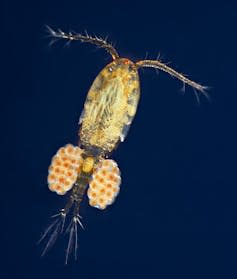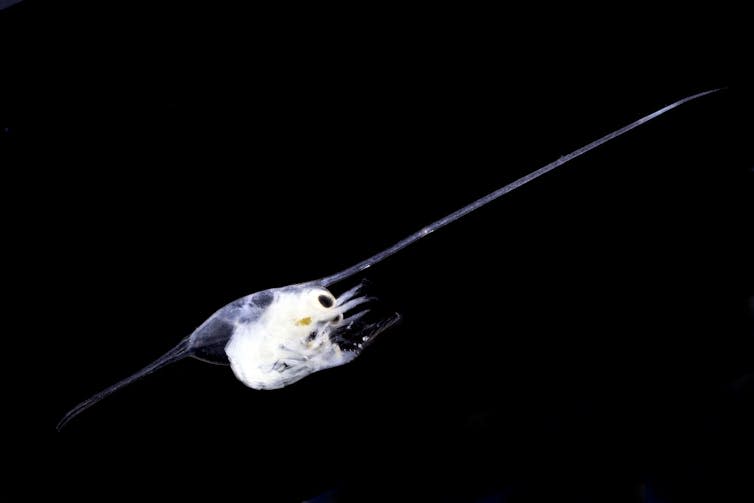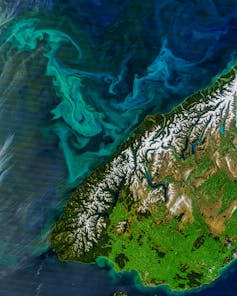If you go to the beach and dip a bucket into the sea, you might initially think it contains lifeless water. But examine that water under a microscope and you will see that your bucket contains a universe of microscopic life, in the form of beautiful and fascinating plankton.
Plankton consists mainly of microscopic algae and animals found throughout Earth’s oceans, seas, and lakes, although a few species are visible to humans. Unlike fish, plankton cannot swim against the current. Instead, they float through the water, floating at the will of the waves and the tides. Plankton is crucial for marine ecosystems and for humans, but often slips under the radar of our interest.
As a plankton ecologist who has worked to raise their profile worldwide, I hope I can convince you that these creatures deserve your attention.
Phytoplankton, the algae plankton, are single-celled organisms. Many of them have chlorophyll, a green pigment (like land plants) that they use for photosynthesis to produce the oxygen we breathe. Over time, phytoplankton have produced about half of the Earth’s oxygen, making our atmosphere habitable today.
Like land plants, phytoplankton form the base of the marine food web. While cows graze grass on land, zooplankton, small marine animals, eat phytoplankton.
Zooplankton includes one of the most common animals on Earth, the copepods: a microscopic crustacean that ranges in size from 0.5 to 15 mm. Large copepods are eaten by fish larvae, which scientists also call plankton because they are too weak and small to swim against ocean currents. These larvae grow into fish that are eaten by animals higher up the food web, such as sharks, birds and humans.

Planktonic krill, a shrimp-like crustacean up to 5 cm in size, makes up most of the diet of the largest vertebrate to ever live on Earth, the blue whale. Blue whales eat by filtering seawater through their comb-like baleen, pushing water out while keeping the plankton in their mouths.
Unlike most sharks, basking sharks and whale sharks do not have teeth and eat copepods, krill and other plankton. It’s amazing to think that microscopic animals make up the diet of such enormous creatures.
Life cycles
Some zooplankton, such as copepods and krill, spend their entire lives in the water column between the surface and the bottom of the sea, rather than on the seabed. Other zooplankton live in the water column only during the larval stages, before maturing and settling on the seafloor or, like larval fish, developing the ability to swim against currents.
In spring, the sea is full of planktonic crab larvae, which wave their tails to swim as they hunt for small copepods and other plankton. Crab larvae don’t look like adult crabs: they have huge spines on the top and bottom of their heads, and are long and thin rather than round with pincers. As crab larvae grow through their life stages, they become more and more like their adult selves, until they eventually fall to the seabed.
Lobsters, mussels, sea snails and barnacles also live as plankton in their larvae stage.


Amazing diversity
Scientists estimate that there are approximately 100,000 plankton species in the sea. Plankton communities vary in Earth’s seas and oceans, especially across latitude. Warmer waters generally have lower plankton biomass and density, and consist of species with smaller body sizes.
Jellyfish, my favorite species of zooplankton, are among the largest plankton. Despite their large size (up to 120 meters long in the case of the Lion’s Mane jellyfish), jellyfish are still considered plankton because they cannot swim against currents and tides. Instead, they pulse through the water.
There are other types of plankton that are much smaller. These are the pico- and nanoplankton that are too small to see with a classical microscope. These tiny plankton absorb nutrients from waste, such as feces, dead organisms and other biological material from other parts of the food web, and help break it down. This microbial loop was only discovered in the 1980s.
There is so much about plankton we still don’t know, and there are thousands of species yet to be discovered.
Climate change canaries
Plankton are extremely sensitive to changes in their environment, meaning they respond quickly to changes in sea temperature and acidity. As sea temperatures rise, warm-water plankton communities move from the equator to new temperate environments, while cold-water plankton communities are pushed toward the poles.
In the Northeast Atlantic Ocean, for example, plankton has shifted more than 1,000 miles north since the 1960s. But these are not the same individuals in motion – this is the entire plankton community in motion, over millions of individual lifetimes.
Some plankton groups use calcium carbonate or chalk to form their shells. As the oceans acidify, plankton that rely on calcium carbonate struggle to form their shells, which protect them from predators and give their bodies structure.
Coccolithophores, a phytoplankton group covered in calcium carbonate liths (external plates), developed deformities in laboratory experiments that manipulated the pH of seawater. We are not yet certain of the extent to which wild populations of coccolithophores are affected by pH changes, but they are certainly important for both the marine food web and for the removal of carbon from the atmosphere.
Plankton may be small, but phytoplankton blooms, which are dense aggregations of microscopic single-celled phytoplankton, can extend across the ocean’s surface for hundreds of kilometers and are visible from space with the help of satellites.


These enormous blooms sink to the seabed when plankton die, transporting carbon to the deep sea and helping fight climate change.
Although these types of plankton blooms are usually a natural phenomenon, they can also occur due to excess nutrients from agriculture or sewage. If the blooms are too large or too concentrated due to excess nutrients, they can cause hypoxic (no oxygen) dead zones on the seabed. These kill everything that lives there, including animals that cannot quickly escape from this dead zone.
Few groups are so biodiverse and so important to the way our oceans, and indeed our entire planet, function. The next time you sit on a boat or on the beach and look at the sea, remember that every drop of water is full of microscopic life that makes our planet what it is.
This article is republished from The Conversation under a Creative Commons license. Read the original article.


Abigail McQuatters-Gollop receives funding from the Natural Environment Research Council and the Department for Food, Environment and Rural Affairs.